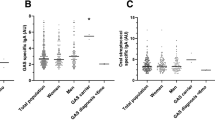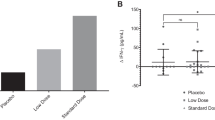Abstract
Introduction
The increasing prevalence of antibiotic-resistant bacteria emphasises the need for new treatments that can replace traditional antibiotics. Oral immunotherapy with yolk antibodies from hyperimmunised hens is a new promising treatment strategy, primarily for infections in the mouth and gastrointestinal tract. Several studies show that bacterial and viral infections can be prevented with egg yolk immunoglobulin (IgY) in a dose-dependent manner. Oral treatment could potentially be used against many frequently encountered diseases (e.g. common cold, tonsillitis and caries).
Group Studied
Healthy volunteers.
Study Design
We studied the presence of yolk anti-Pseudomonas aeruginosa antibodies in saliva from healthy volunteers over time after 1 or 2 minutes’ mouth rinse, performed in the evening, with an aqueous IgY antibody preparation. The test persons rinsed the mouth with 8.0ml phosphate buffered saline before gargling with the antibody preparation 8 and 24 hours later. Statistical analysis was performed with the Mann-Whitney U test.
Methods
The antibody titres in the mouth rinses were tested for their specific activity against P. aeruginosa by ELISA.
Results and Conclusion
The next morning there were still active antibodies detected in the saliva from 18 of 19 subjects. After 24 hours, active antibodies could be detected in saliva from only a few of the subjects. A 2-minute mouth rinse resulted in higher mean ELISA absorbance values than a 1-minute rinse.




Similar content being viewed by others
References
Carlander D, Kollberg H, Wejaker PE, et al. Peroral immunotherapy with yolk antibodies for the prevention and treatment of enteric infections. Immunol Res 2000; 21(1): 1–6
Larsson A, Balow RM, Lindahl TL, et al. Chicken antibodies: taking advantage of evolution: a review. Poult Sci 1993; 72(10): 1807–12
Yokoyama H, Peralta RC, Umeda K, et al. Prevention of fatal salmonellosis in neonatal calves, using orally administered chicken egg yolk Salmonella-specific antibodies. Am J Vet Res 1998; 59(4): 416–20
Ikemori Y, Ohta M, Umeda K, et al. Passive protection of neonatal calves against bovine coronavirus-induced diarrhea by administration of egg yolk or colostrum antibody powder. Vet Microbiol 1997; 58(2–4): 105–11
Cama VA, Sterling CR. Hyperimmune hens as a novel source of anti-Cryptosporidium antibodies suitable for passive immune transfer. J Protozool 1991; 38(6): 42S–3S
Hamada S, Horikoshi T, Minami T, et al. Oral passive immunization against dental caries in rats by use of hen egg yolk antibodies specific for cell-associated glucosyltransferase of Streptococcus mutans. Infect Immun 1991; 59(11): 4161–7
Otake S, Nishihara Y, Makimura M, et al. Protection of rats against dental caries by passive immunization with hen-egg-yolk antibody (IgY). J Dent Res 1991; 70(3): 162–6
Carlander D, Kollberg H, Wejaker PE, et al. Prevention of chronic Pseudomonas aeruginosa colonisation by gargling with specific antibodies. In: Sim JS, editor. Egg nutrition and biotechnology. Wallingford, Oxon: CAB International, 1990: 371–4
Kollberg H, Larsson A, Carlander D. More than four years without any new pseudomonas infections at Uppsala cystic fibrosis centre [abstract]. Pediatr Pulmonol Suppl 1998; 17: 313
Ratnaningsih E, Dharmsthiti S, Krishnapillai V, et al. A combined physical and genetic map of Pseudomonas aeruginosa PAO. J Gen Microbiol 1990; 136(Pt 12): 2351–7
Lanyi B, Bergan T. Serological characterization of Pseudomonas aeruginosa. Methods Microbiol 1978; 10(IV): 94–168
Akita EM, Nakai S. Immunoglobulins from egg yolk: isolation and purification. J Food Sci 1992; 57(32): 629–34
Carlander D, Sundstrom J, Berglund A, et al. Immunoglobulin Y (IgY): a new tool for the prophylaxis against Pseudomonas aeruginosa in cystic fibrosis patients [abstract]. Pediatr Pulmonol Suppl 1999; 19: 241
Pedersen SS, Jensen T, Hoiby N, et al. Management of Pseudomonas aeruginosa lung infection in Danish cystic fibrosis patients. Acta Paediatr Scand 1987; 76(6): 955–61
Levy SB. The challenge of antibiotic resistance. Sci Am 1998; 278(3): 46–53
Nicolaou KC, Boddy CN. Behind enemy lines. Sci Am 2001; 284(5): 54–61
Shale DJ, Elborn JS. Lung injury. In: Shale DJ, editor. Cystic fibrosis. London: BMJ Publishing Group, 1996: 62–78
Bernhisel-Broadbent J, Yolken RH, Sampson HA. Allergenicity of orally administered immunoglobulin preparations in food-allergic children. Pediatrics 1991; 87(2): 208–14
Russo M, Nahori MA, Lefort J, et al. Suppression of asthma-like responses in different mouse strains by oral tolerance. Am J Respir Cell Mol Biol 2001; 24(5): 518–26
Matsunaga Y, Wakatsuki Y, Tabata Y, et al. Oral immunization with size-purified microsphere beads as a vehicle selectively induces systemic tolerance and sensitization. Vaccine 2000; 19(4–5): 579–88
The international egg commission [online]. Available from URL: http://www.internationalegg.com [Accessed 2002 Nov 1]
Hochberg MC, Tielsch J, Munoz B, et al. Prevalence of symptoms of dry mouth and their relationship to saliva production in community dwelling elderly: the SEE project. Salisbury Eye Evaluation. J Rheumatol 1998; 25(3): 486–91
Acknowledgements
This work was supported by NUTEK and Stiftelsen Samariten. The authors have no conflicts of interest that are directly relevant to the content of this manuscript.
Author information
Authors and Affiliations
Corresponding author
Rights and permissions
About this article
Cite this article
Carlander, D., Kollberg, H. & Larsson, A. Retention of Specific Yolk IgY in the Human: Oral Cavity. BioDrugs 16, 433–437 (2002). https://doi.org/10.2165/00063030-200216060-00004
Published:
Issue Date:
DOI: https://doi.org/10.2165/00063030-200216060-00004




